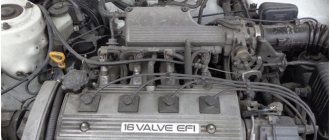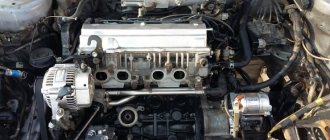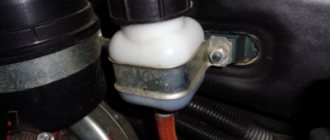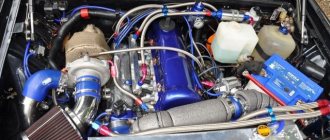Briefly about the Niva Chevrolet car
As it states, this is a modern SUV with all-wheel drive, which was in development for a long time, but was nevertheless presented to the Russian consumer. And very soon a new version of the car is also preparing to enter the world.
But, unfortunately, the Togliatti plant cannot always find suitable suppliers of components, which negatively affects the development process and the speed of release of the new model.
Nevertheless, manufacturers often manage to find a worthy alternative; today the Niva equipment meets Euro-5 standards. In Russia, this car was twice awarded the title “SUV of the Year”.
Service
To achieve maximum service life, it is important to properly maintain the motor.
First of all, it is worth remembering the importance of timely replacement of engine oil. It is recommended to carry out this work once every 15 thousand kilometers.
Every second replacement should be combined with washing. This recommendation applies to both engines.
It is also worth choosing the right oil. The Z18XE engine should only be filled with synthetics; the best options would be:
It will require approximately 4.5 liters.
The VAZ-2123 engine is filled with 3.75 liters of lubricant; here it would also be optimal to use synthetics. For other parameters, you can use the same oil as for the engine described above.
The VAZ-2123 engine has a timing chain drive. In this regard, it is changed quite rarely. The average service life between replacements is 150 thousand kilometers. At the same time, the manufacturer does not regulate the time of replacement. Everything is determined by the signs of a problem, first of all we are talking about increased engine noise, especially when picking up or dropping speed.
The Z18XE motor is belt driven. According to the manufacturer's specifications, it must be replaced at 60 thousand kilometers. And according to the experience of car enthusiasts, it is better to do this after 45-50 thousand, as there is a risk of breakage. In this case, you will get bent valves.
One of the popular types of tuning is SWAP. In this case, the motor with poor performance is simply replaced with another, more suitable one. There are many options for such modification. First of all, you should decide what you need and what engine is standard. If you have a VAZ engine installed, you can try installing a Z18XE, in this case you will get an increase of almost 40 hp. and you won't have to redo anything at all. Well, if only the gearbox is changed.
Also, quite often, drivers install the VAZ 21126, which is standardly intended for the Priora. As a result, you will get a longer resource, as well as slightly increased power. To install, you will need to modify the exhaust manifold; it is placed on a thick gasket of 2-3 cm, then the pants will not come into contact with the spar.
Few people know that it was planned to release a diesel version of the Chevrolet Niva. It was supposed to use an engine manufactured by Peugeot - XUD 9 SD. It is almost ideal for Shniva. To install it, no modifications are required at all, only flashing the ECU, after all, the engine is diesel.
For cars with Z18XE, the same recommendations are suitable as for the VAZ unit. The only caveat is turbocharging. The fact is that this engine was originally intended and used for Opel. For German cars there was an option with a turbine. So you can install it, increasing engine power and throttle response. No modifications other than additional tuning of the ECU will be required.
History of Niva production and its main modifications
The production of the Chevrolet Niva first began in the mid-1980s of the last century, but the very first version - the prototype of the modern Niva - VAZ-2123 - saw the world only in 1998. It was produced for a very short time - until 2002, production was in small quantities.
In 2002, the production license was purchased by the General Motors concern, and a new SUV based on the old one appeared - the Chevrolet Niva.
The very first Chevrolet Niva was produced in two models: L and the more advanced GLS.
Since 2006, the FAM-1 appeared, which lasted only a couple of years and was discontinued.
In 2009, a new model Niva went out of production. It currently exists in L, LC, LE, GLS, GLC and LE+ trim levels.
At the moment, the Chevrolet Niva-2 is expected to be released with an updated engine and new equipment.
Self-installation of a Peugeot engine
There are also Nivas on which diesel owners install diesel engines in makeshift conditions, or they turn to Special 100, which specialize in changing engines.
Options for which diesel unit to install
to Niva, significant volumes. The most common diesel engine for our client is the XUD-9SD from Peugeot. In the end, it turns out that version 212151 is made from an ordinary Niva by changing the engine.
Such a diesel engine is much easier to install on a car, since the mounting points on the XUD-9SD are exactly the same as on the original internal combustion engine. It is worth considering that, in addition to changing the motor itself, some modifications have to be made. It is also possible to install on the Niva, instead of the XUD-9SD, the XUD 11 unit, produced by the same Peugeot.
In addition to the engine itself, it will be necessary to change the gearbox. This is due to the fact that the original VAZ gearbox will not be able to withstand the loads that the diesel engine
unit. Instead of a VAZ box, a Fiat Polonaise gearbox is often installed. It is used because the same XUD-9SD unit was installed on the Polonaise. The clutch housing is also installed together with the gearbox.
Already today, owners who convert the Niva to the XUD-9SD diesel engine also additionally change the front mounting supports of the unit. The pallet also undergoes transformations. It will also be necessary to redo the exhaust system. To ensure additional reliability of front drive parts, some parts are replaced with similar ones from Chevrolet Niva.
To ensure proper cooling of the power plant, the standard radiator is often replaced with a radiator from a Gazelle. At the same time, the rubber pipes are also changed. It wouldn’t hurt to install a heating system for diesel fuel during cold weather that allows accounting (software) to be maintained.
After all these alterations and modifications, you will need to submit documentation to the traffic police.
Technical characteristics of GLS and L engines
The first versions of the cars were produced with domestically produced engines, fully adapted for this brand.
The gasoline engine of the Chevrolet Niva, like most cars, was located at the front. It was designed in such a way that fuel was supplied through distributed injection using a submersible pump.
The engine included four cast iron cylinders arranged in a line, each with a diameter of 8.2 cm. For each of them, two valves were provided. The stroke of the pistons in the cylinders, as before, was 8 cm. The design developed by the engineers made it possible to create a fundamentally new and technologically advanced engine, the working volume of which was 1690 cm3 with a relatively high compression ratio of 9.3.
At three thousand revolutions, a maximum torque of 127.5 Nm is achieved in the Chevrolet Niva. Engine power is 80 horsepower at five thousand revolutions.
Malfunctions and repairs of the VAZ-2123 engine
Below are the main breakdowns of the motor in question and how to fix them:
Engine disadvantages
The first Chevrolet Niva engines were better than their predecessors, the VAZ-2123, but had the following disadvantages:
- high noise level;
- tendency to overheat, frequent appearance of smoke;
- large vibrations when starting the engine;
- consumes a lot of lubricants.
This Chevrolet Niva engine is found in a large number of domestically produced cars, so it is necessary to properly care for it in order to delay repairs and increase its wear resistance.
When handling the engine, you must adhere to the following rules:
- The coolant must be replaced every 60,000 km;
- the coolant also needs to be changed - if its color has changed, this indicates the appearance of additives that behave aggressively towards the mechanism;
- deposits may form in the crankcase ventilation system, making it difficult to remove gas; for this purpose, the ventilation must be periodically cleaned;
- It is necessary to monitor overheating; if smoke appears, open the hood to allow air to enter.
Major changes
The transmission in the motor of the series in question is called Gates. This is a standard belt with the following characteristics:
- standard length – 1888 mm;
- element width – 17 mm;
- number of wedges – 5 pcs.
In the updated 2123 engine, design nuances also include the following updates: a different configuration of the engine compartment and a redesigned bridge beam. The shape has changed due to the absence of a front axle gearbox clamp directly to the power unit. In this regard, the option under consideration is incompatible with accessories and elements of earlier versions from this manufacturer.
Technical characteristics of the FAM-1 engine
One of the most important differences of the new car model was the engine with sixteen valves, borrowed from the Opel car, with a volume of 1.8 liters.
This engine, compared to the previous one, has become more economical, significantly reducing fuel consumption.
The new four-stroke engine of the Chevrolet Niva with forced ignition helps the car accelerate faster to the required speed; the rated power has been significantly increased - up to 125 horsepower. The maximum torque was 167 Nm at 3800 rpm.
Since the engine was not originally intended for Chevrolet, the design of the oil pump intake and oil pan were changed. The power supply system was also improved and a “cat collector” appeared to meet toxicity standards according to Euro-4 standards.
Air intake
The new Chevrolet Niva (2018) is equipped with a completely redesigned air intake system. The main difference is a significant increase in the dimensions of the air filter. This is visually noticeable by the impressively grown body. In addition, the design of the intake pipes, receiver, and throttle element has been modified.
The electronic system of the vehicle has also been transformed. The main control of the “engine” is carried out by the controller. In other variations, an analogue of “January 7.2” was mounted. This feature affects the comfortable interface for the consumer, and also allows you to control fuel consumption thanks to an improved injection control system with a parallel pair configuration. As a result, the new Chevrolet Niva (2018) began to comply with Euro-2 standards in its standard version. To reduce the emission of harmful substances, it is possible to additionally install phased fuel supply. This approach raises the environmental bar to Euro 3 levels while simultaneously optimizing its more accurate delivery.
You may be interested in:Domestic SUV "Niva" for hunting and fishing
Engine of the restyled Chevrolet Niva
Since the disappearance of the FAM-1 engine, many design changes have been made to the Chevrolet Niva car. The characteristics of the engine and its main indicators remained almost the same, but many parts were modified and became much better in operation and more wear-resistant.
Thus, modern engines have the following advantages:
- the pistons have been improved due to the reinforcement of the skirt;
- connecting rods have become lighter;
- the tensioner drive has become hydraulic;
- the double-row chain was replaced with a new one - quieter and lighter;
- the fuel filter changed its location and was moved to the underbody;
- the motor received a new control system - a special electronic unit, thanks to which starting has become easier;
- traction has been improved, making it possible to change gearbox speed less often;
- The Chevrolet Niva engine has a dual lubrication system - under pressure and by splashing;
- the neutralizer received an additional muffler;
- injectors and an ignition coil of our own production appeared, fully adapted to the car;
- toxicity level meets Euro-5 standards;
- the jets limit the volume of sucked gases, thus at idle speed the operation of the engine is not disrupted;
- on the Chevrolet Niva, engine cooling has become better due to increased airflow.
The engine stalls when idling or while driving
In this case, problems with the 2123 engine may be as follows:
Engine design features
The engine cylinders are united by a single cast-iron block, at the bottom of which there is a crankshaft; it is also cast-iron and at the same time sealed with updated oil seals.
Liners made of an alloy of steel and aluminum are used as bearings.
The cylinders have an inlet and an exhaust valve, the rods of which are nitrided and electric-hardened.
The pistons with complex skirt configurations are made of tin-coated aluminum.
The camshaft is driven by a single row chain, which also helps the oil pump drive shaft rotate. The oil pump flow rate has been increased compared to the earlier version due to changes in the drive shaft design.
The spring-hydraulic tensioner supports the chain using a specially enlarged shoe. A chain guide is also provided.
The motor has a dual lubrication system: spray and pressure.
The cooling system is provided by a cooling jacket, combustion chambers, a centrifugal water pump and a thermostat.
As already mentioned, ignition occurs under the control of a special electronic unit.
Motor device
Briefly about how the VAZ 2123 Chevrolet Niva engine works.
Cylinders
They were combined with the upper part of the crankcase. Like most VAZ engines, this power unit has cylinders operating in a 1-3-4-2 pattern. The lower part of the cylinder block is connected on five supports to the crankshaft.
1 — tension roller of the air conditioning compressor drive belt; 2 — air conditioning compressor drive belt; 3 — air conditioning compressor clutch; 4 — thermostat; 5 — throttle assembly; 6 — outlet pipe of the cooling jacket; 7 — coolant pump pulley; 8 - phase sensor; 9 — tension roller for the auxiliary drive belt; 10 — cylinder head; 11 - generator; 12 — power steering pump pulley; 13 — support roller for the auxiliary drive belt; 14 — cylinder block; 15 — auxiliary drive belt; 16 — crankshaft position sensor; 17 — auxiliary drive pulley; 18 — air conditioning compressor drive pulley; 19 — oil pan; power unit support; an exhaust manifold; receiver; cylinder head cover;
Crankshaft
Five-legged. Cast from cast iron. If necessary, the journals can be reground with a diameter reduction of 0.25; 0.50; 0.75 and 1 mm.
Also interesting: How much oil is in the Niva 21214 engine
Exhaust valves
Welded in two parts. One is an alloy of chromium, nickel and molybdenum, and the other is made of multi-component steel. The operating temperature of the exhaust valves is 700-900 degrees, since during engine operation they are heated by processed gases. In order for them to withstand such temperatures, a special heat-resistant alloy is applied to them.
Intake valves
Their rods are treated with nitrogen and hardened under the influence of high frequency current. This is enough to withstand operating temperatures of 350-500 degrees.
Pistons
The VAZ 2123 engine has pistons cast from an aluminum alloy. A layer of tin is applied to them to make the process of breaking in the car faster. The piston stroke is 80 mm, and it itself has a diameter of 82 mm. The compression ratio is at 9.3 atmospheres.
Camshaft
Cast from cast iron and installed in a removable aluminum housing. Its rotation is carried out by a single-row roller chain.
Chain
It is stretched by a spring-hydraulic tensioner. Its size has increased significantly. Until the engine starts, the tension is carried out by a spring, and during its operation it is provided by oil pressure.
Cylinder head
Attached to the block itself with 11 bolts. Centering is performed using the power of two bushings.
Lubrication system
It is carried out using the pressure and spray method, which helps to save oil.
Crankcase ventilation system
Closed, and crankcase gases are discharged through the oil separator into the intake pipe. From there they are transferred to cylinders and burned.
Cooling system
The fluid circulation is forced and is produced using a centrifugal pump.
Ignition system
Controlled by an electronic unit. The ignition module is located on the cylinder block and is powered by the battery.
New engine for Chevrolet Niva cars
In 2021, production of new engines was launched.
The motor is suitable for some Lada models, as well as the Chevrolet Niva. The 1.8 liter engine is made on the basis of the old VAZ-21127, with a volume of 1.6 liters.
Significant changes have appeared in the design and characteristics of the new engine:
- the appearance of an additional oil channel between the cylinders;
- a mechanism for changing the gas distribution at the inlet appeared - the mass of parts was reduced, which helps to let in more air and reduce friction between surfaces;
- the bearing housing has been changed, which allows you to add a phase sensor;
- a precise system for installing the timing drive has appeared, making phase adjustment more accurate;
- the piston height has increased, which allows the engine heating temperature to be reduced;
- the upper crankshaft liner has a different groove shape, which helps save lubricant consumption;
- the water pump was replaced with a pump, with its help pumping liquids through the engine will be better;
- The performance of the oil pump was almost doubled, and the diameter of the oil intake pipe was also increased for this purpose.
The Chevrolet Niva, whose new engine will be more powerful and more economical, will be faster and more reliable. The characteristics of the new motor are as follows.
Power – 122 horsepower at 6 thousand rpm.
Torque has increased to 170 Nm and is achieved at 3,700 rpm.
About the power unit of the model
This VAZ 2123 model is equipped with a Chevrolet Niva engine of an improved design. First of all, car owners note a noticeable reduction in noise from the power unit. This was achieved through the use of a hydraulic tensioner mechanism for timing chains. The Chevy Niva engine is a traditional design with a vertical arrangement of four cylinders. The electronic engine management system controls fuel injection into the combustion chambers of the engine.
Some changes took place in the timing drive; the chain began to be installed as a single-row one, and this entailed the installation of new gears, which also have one row of teeth. Another innovation of this engine was the use of sensors that began to monitor detonation. These and other innovations allowed the developers to obtain a power unit that fully complies with the European standard EURO 2, which regulates emissions of toxic substances from exhaust gases. Let us consider in more detail the description of the car and its power unit.
Reviews of Chevrolet Niva engines
There are different points of view regarding which engine on the Chevrolet Niva is good or bad.
According to car owners, the engine is reliable, but rather weak. The car takes a long time to accelerate, but it’s quite possible to drive at a speed of one hundred and forty to one hundred and sixty km/h. Drivers report high noise levels.
Many car owners complain about the small engine size. The problem is solvable; with minor repairs, it is possible to increase the piston stroke by two mm, increase engine volume to two liters, and power to one hundred horsepower.
On the positive side, it can be noted that the engine, if properly cared for, does not break down often, and it practically does not rust. In case of repair, the parts are inexpensive and quite available on the market.
After 2014, the Chevrolet Niva, whose engine speed was slightly increased, became more maneuverable. In addition, after a number of changes by the manufacturer in the engine design, car enthusiasts noticed a decrease in noise levels, better performance of the water pump, and a decrease in fuel and lubricant consumption.
In addition, many car owners are interested in replacing the old engine with a new one with a volume of 1.8 liters. The Chevrolet Niva, whose new engine has been tested by the manufacturer, promises to be easier to drive and even more economical.
Other tuning options
One of the improvement options is to improve the cylinders for more efficient operation of the updated piston. Reformation involves boring these elements to a width of 84 mm. Properly performed work in this direction will allow the owner to increase the engine capacity of the 2123 Chevrolet Niva to 1.9 liters. In this case, it will be necessary to additionally change some parts associated with the assembly. Replacing the old carburetor with a new version, as well as installing lightweight connecting rods, will also make it possible to slightly increase the power of the car.
VAZ 21213
| Name | Index |
| Engine capacity | 1.7 liter (1690 cc) |
| Number of cylinders | 4 |
| Number of valves | 8 |
| Fuel | Petrol |
| Injection system | Carburetor |
| Power | 82 horsepower |
| Fuel consumption | 11.0 l/100 km |
| Cylinder diameter | 82 mm |
| Valve mechanism | SOHC |
Which modification is better
It is impossible to say unequivocally which engine is more reliable and better. A lot depends on how you use the car. For urban conditions, the Z18XE is better suited; it is more effective on asphalt. The VAZ-2123 has lower revs, which is very good off-road.
If we take reliability into account, both cars break down. But the Z18XE has much fewer minor faults that ruin the lives of car enthusiasts. At the same time, the VAZ-2123 is well known for minor problems with leaks, sensor failures and other shortcomings.
How to secure overtaking? What can be done to prevent Niva from falling out of the flow? How to add agility to a popular SUV on the highway?
Chevrolet > Niva
How can you improve the internal combustion engine?
How much does tuning a VAZ 2123 cost? This question is asked by many car enthusiasts. The second question is how to do engine tuning for a Niva Chevrolet with your own hands? The design of the motor and its characteristics can be significantly improved. In a Chevrolet Niva car, tuning its engine is possible. There are several methods available for this:
- Chip tuning of the power unit;
- The volume is increased mechanically;
- Manipulations with pistons, crankshaft;
- Finishing the cylinder head.
When deciding to tune a Chevrolet Niva engine or its engine, you should take into account the fact that Chevrolet Niva engine tunings are not designed for driving at high speeds. The main purpose of the Chevrolet Niva after engine tuning is to improve driving in bad road conditions. Therefore, tuning the 2123 Chevrolet Niva engine should be aimed at increasing torque and improving the torque of the engine. Based on this, they choose one or another amount of work to improve the Chevrolet Niva engine.










